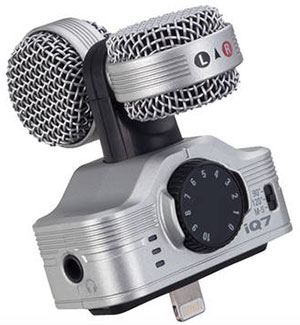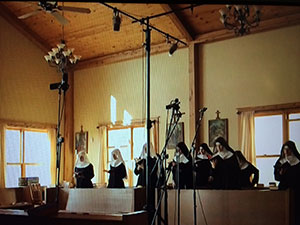Here’s a video tutorial from The Reaper Blog about recording doubled guitars on Reaper. Check out the video here. It’s the best way I know of to get a huge guitar sound – even better than recording a single guitar with a stereo mic (or pair of mics).
to summarize the process, simply record your guitar on one track. Then record the SAME part again, on a second track. Once that is done, just pan one of the tracks to the left and the other track to the right. The resulting sound will be a really cool stereo acoustic guitar sound. Try it. You’ll love it:).
stereo
New Zoom Mid-Side Stereo iPhone Mic Now Available

Just announced at the 2015 Winter NAMM (National Association of Music Merchants) trade show, the new mid-side stereo mic iPhone attachment – the Zoom iQ7 – is available as of today at B&H.
Why is this such a big deal? There are plenty of stereo mics out there that can attach to the iPhone these days. But this is the first mid-side stereo attachment mic that I’ve seen. And THAT is what makes it such a big deal.
Mid-Side Versus “Regular” Stereo
So what is so special about this thing I keep calling “mid-side (M/S)?” And what the heck does M/S mean anyway? In a nutshell (see our article “5 Audio Recording Tips For Newbies – Part 1: Stereo Or Not?” for a primer on stereo recording), stereo mics are usually set up to where two microphones are pointing in different directions toward the subject. The idea there is to try and mimic the way a human head (specifically the ear parts of the head) picks up sound naturally, that is from slightly different places in space (the left and right sides of your head). So two mics will theoretically provide timing cue differences which your brain will convert into a more spacious, more natural sound than a mono or “point’ sound source.
The problem with the traditional two-mics-pointing-in-slightly-different-directions method is that once it’s recorded, you have very little flexibility to change the stereo “image.” But with M/S, which is typically a bit more complicated to do (you need two different types of mics – a figure-8 mic and a cardioid mic – and they have to be set up in a very particular way), you not only get a wonderful stereo sound, but you can adjust the width of the stereo image after the fact! M/S is the preferred stereo technique for broadcast recording, mainly because when the two stereo channels are converted to mono (as is often done for radio), the audio doesn’t suffer. With standard stereo techniques, you often get phase cancelation problems (meaning “the audio sounds odd”) when converted from stereo to mono. M/S is also often used for live recording because of how much control you have over the stereo field in the mixing stage. There is a nice article about M/S stereo recording on the Universal Audio (UA) site here: http://www.uaudio.com/blog/mid-side-mic-recording/
So THAT is why I’m so excited about this brand new microphone attachment for the iPhone. The iQ7 works with the newer devices that use the lightning connector. And the price is fantastic at just $99.99 at B&H. CLICK HERE to find out more or to order one for your very own!
Recording The Benedictine Sisters – Multiple Stereo Mic Set-Ups
 There is a chart-topping music group you may not have heard of – the Benedictine Sisters of Mary, Queen of Apostles. They have recently topped Billboard’s Classical Albums charts with two of their three albums.
There is a chart-topping music group you may not have heard of – the Benedictine Sisters of Mary, Queen of Apostles. They have recently topped Billboard’s Classical Albums charts with two of their three albums.
Why do I mention this? Well, we were watching CBS Sunday Morning on Easter Sunday, and they did a story about the Sisters. One scene showed a recording session with lots and lots of microphones. Of course I immediately exclaimed “hit pause!” to my wife (who controls the DVR remote;)). There were so many mics in so many different positions that I really wanted to study what was going on.
What WAS Going On?
The first thing I thought I recognized was something called a Decca Tree. this is a type of stereo recording set-up developed in the 1950s at Decca Records. It’s a tall pole with a “T” shaped horizontal crossbars at the top which holds three microphones. It was used to best capture orchestras by using a spaced pair (left and right) of mics, combined with a third mic to pick up stuff going on in between. You can see crossbars of the Decca tree at the top of the picture up above. Incidentally, the microphones being used on the tree are Neumann TLM-102 large diaphragm condenser mics (or possibly the TLM-103, which have the same shape). I’re read about the Decca tree configuration before, but I’d never actually seen one. Then I saw what record label had produced and distributed the Sisters’ albums – yup, Decca. Duh.
But that wasn’t the only stereo recording configuration they had! A closer look reveals that there is at least other stereo mic set-up, two instances of the mid-side (m/s) set-up (one for each side, since the nuns were split into two sides of the room). In addition to those three stereo mic clusters (seven microphones so far), there are two spot microphones aimed into the group of nuns agains the far wall in the picture. They are placed high and look to be positioned to capture the room/ambient sound. The spot mics appear to be small-diaphragm condenser mics, such as the Shure SM81.
So with two mid-side groupings and one Decca tree, combined with two room mics, this small choir was recorded with nine microphones! And very high-quality microphones they were. It’s no wonder that the production quality of their last three CDs (they had recorded their own prior to Decca arriving at the door) were so high that they ended up selling so well that they ended up on the Billboard charts. DON’T get me wrong! It’s not ONLY the quality of the production that got them on the charts. A really well-recorded bunch of crappy singers would still be that – polished crap. But the Sisters sing like angels. They will tell you (literally – they did in the interview) that they aren’t great singers. But they practice 5 hours a day. Funny how much difference tons of practice combined with excellent recording technique (from the pro engineers working for Decca) and top-notch gear can make.
What The Beatles Can Teach Us About Mixing Music
This post was originally published in 2012. But given that this month is the 50th anniversary of the Beatles coming to America and playing on the Ed Sullivan Show, I thought I would revive it this February.
I’ve been a student of recording and mixing for almost 3 decades. In that time the standard “rules” for mixing music have been pretty universal. If not for the fact that I got into it a mere 15 or so years after The Beatles broke up, I would have thought these mixing rules had been around forever. Certain things like panning the kick drum, bass guitar and lead vocal to the dead center of the mix (in other words, not panning them at all), and balancing the stereo field with guitars, pianos, harmonies and other instruments placed across the sound stage so we hear them spread out left-to-right, were things that “everybody knows.” But they’ve only known them since about 1970 or so.
But I’ve been listening to a lot of Beatles music in the past few weeks. Thank you iTunes and Apple Records (no relation) for finally coming to a sane agreement to make their music available for download! When I was a kid I didn’t notice that things were a bit wonky on the records I had. Maybe I had original recordings where they were in mono (nothing panned left or right), I really don’t know. And since my brother took all my records decades ago, I can’t check – not that I am bitter.
But in listening to The Beatles these past few weeks I became acutely aware of how hard it was to listen to at times. I mainly listened while driving in the car (…”yes I’m gonna be a star” – sorry), so when songs had all the drums panned to the left channel and a lead vocal coming from the right channel all the way over in the passenger side door, I couldn’t fully enjoy the music because part of my brain was trying to hear the lead vocal and another part was freaking out about how “wrong” the mix was.
I thought I had remembered that the whole concept of stereo was new in the 1960s, at least for use in pop records, and that The Beatles were early pioneers and tried all manner of wacky mixing. But it turns out only part of that was true – the part about stereo being new. George Martin and crew produced everything (at least before the days of The White Album and Abbey Road ca 1968/1969) for mono, and that is the way they sound the best. The early recordings, up until 1964, were recorded on “twin-track” tape. So the instruments all went on one track, and the vocals went on the other. That makes sense if two tracks is all you have. It lets you mix it so that the vocals and instruments blend and balance properly. Those songs were optimized for mono and how they were meant to be heard. It wasn’t until 1966 or so that George Martin and crew decided to remix a bunch of songs for stereo, without the involvement of The Beatles themselves.
So when the early recordings prior to Rubber Soul were changed for stereo, the only choice they had was to put instruments on the left channel and voices on the right, leaving a kind of sonic hole in the middle. This sounds really odd to our post-1960s ears. But even when they started recording on 4-tracks start with Rubber Soul, they didn’t change the instruments-to-the-left and voices-to-the-right tactic except for a few exceptions where a guitar might show up in the right channel, or a harmony might be panned to the left.
Almost nobody in The Beatles’ primary listening audience (teenagers) at the time owned stereo record players. They were all listening on what they called “monaural” or “monophonic” players. So when George Martin was experimenting with stereo mixes, he wasn’t too worried about ruining anything because he knew very few people would ever actually hear the stereo versions. But as is often the case with technology, stereos became common around 1970, so those “stereo” versions were out in the world for better or worse. In the 1980s, George Martin did some much needed remixing to improve the stereo mixes, and they are better now. Things are spread more evenly across the stereo sound-stage. But he still only had 4 tracks to work with, so not every instrument or voice is on its own track. The drums, for example, are still all mixed to the left because they were all on a single track.
All this got me thinking about how quickly things become standard and rules become universal and in some cases, inviolate. But there were no stereo mixing rules just a few decades ago. The things we consider to be “correct” are not age-old wisdom as I was treating them. On the one hand it’s a good thing. It makes it easy to teach people how do do things. On the other hand, it can stifle creativity. What seems right and proper in the audio recording industry today may turn out to be “wrong” 20 years from now.
The Beatles changed a lot of those rules in the 60s in other areas, like recording backwards music, doubling lead vocals and guitar leads, applying more treble than the engineer said was correct on Nowhere Man, and the list goes on. So while we are recording, let’s remember that rules are often made to be broken in the name of creativity. Who knows? You may end up writing the new rules.
Creating Recordings With More Space and Depth
 One major goal of most audio recording projects is to create a natural sounding product for the listener – in much the same way that video seems to look better to us, less “flat,” when it has more depth and dimension. Note how popular it is to see movies in 3D. But even without 3D movie effects and glasses, film makers started using focus and blur, light and shadow, forced perspective, etc. to help create a more realistic space for the viewer. You can do similar things in audio.
One major goal of most audio recording projects is to create a natural sounding product for the listener – in much the same way that video seems to look better to us, less “flat,” when it has more depth and dimension. Note how popular it is to see movies in 3D. But even without 3D movie effects and glasses, film makers started using focus and blur, light and shadow, forced perspective, etc. to help create a more realistic space for the viewer. You can do similar things in audio.
One way this can be done, especially when recording music (since there are usually many sound sources), is to provide the listener with cues that give the audio some space – in multiple dimensions – as they are used to hearing it in real life.
Left-to-right
Most listening devices are stereo or better (surround, for example) these days. So you should take advantage of that. Multi-track recording software (DAWs) allow you to “pan” each track to the left or right by as much as you want. So you can spread things out from left to right to make them sound to the listener like the instruments are spread out as they would be in real life.
Sometimes you might want to widen a single sound. For example, a piano almost always sounds best when it is recorded in stereo. The instrument is large and wide in real life and people typically expect to hear it that way on a recording too. But what if you only have a mono recording of a piano? How can you widen it? Well, you can use a technique that plays a trick on the listener’s brain – called the Haas Effect. You can read more detail about this in our post The Haas Effect, but basically you can make a copy of a mono track, delay it slightly in time, and then pan both versions apart.
Of course certain things may be recorded in stereo – either with two mics or a stereo mic – and others in mono. Then you space things out across the horizontal spectrum to give them a more natural feel.
Front-to-back
Another thing people are used to is natural reverberation. You may not notice it in real life, when speaking to someone. But if somehow the voice of the person your were talking to were to suddenly lose all room reverberation (which is what happens when the sound bounces off the walls, ceilings, and everything around it), it would sound very odd. So in your recordings, in order to make something sound more natural (assuming that’s what you want – which you may not. For example, some kinds of voice-overs intentionally sound a bit unnatural – deep and in-your-face like it’s coming from inside your brain), it helps to add some front-to-back space using reverb effects. For example, if a voice or other instrument sounds too “up-front,” you can give the illusion of pushing it back and further away by adding some reverb.
Another way to make things sound further away is by turning them down. In real life, things that are farther away have less volume than the same sound up close. This is one of the most basic things you do when mixing sounds together.
Bottom-to-top
This idea may be more applicable to making a music mix sound more full, rather than more natural. But it does help to fill out a sound pallet for a listener. Try to provide sound that covers the frequency spectrum from low/deep sounds like bass guitar, kick drum, tympani, bass fiddle, etc. all the way to high sounds like cymbals, high-hats, tambourines, piccolos, guitars capo’d way up, etc. The middle frequencies can be filled with voices, guitars, pianos, violins, violas, etc.
The way we use this in our music recordings is to listen to a mix and decide if there is a hole somewhere, or if we are missing highs or lows. For example, we were working on a song that had a guitar with no capo, a bass, a bodhran hand drum and a male voice with male harmony. It was decidedly “low-heavy.” That told us we needed to add some higher frequency stuff to help balance it out. So we added a guitar with a capo on the 5th and/or 7th fret, a female harmony, and a tambourine. We might also have added a mandolin, flute, high fiddle, etc. Doing that really helped to provide a full and rich sound that was balanced.
So to sum up, you can really improve your audio recordings by adding more depth and dimension using several pretty common recording techniques.
Hope that gives you some tips to make your audio sound awesome!
